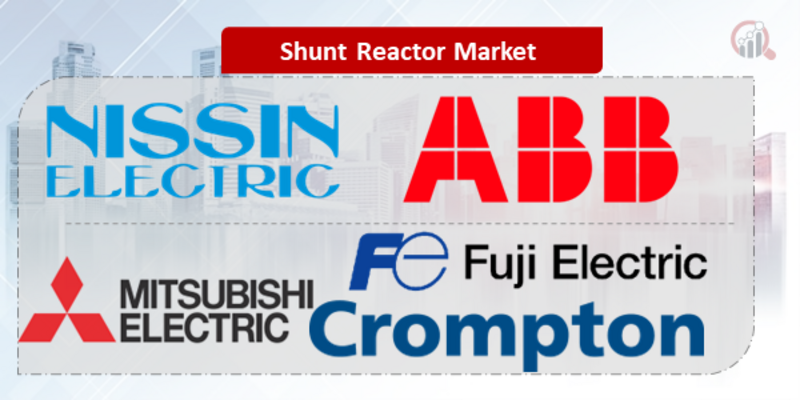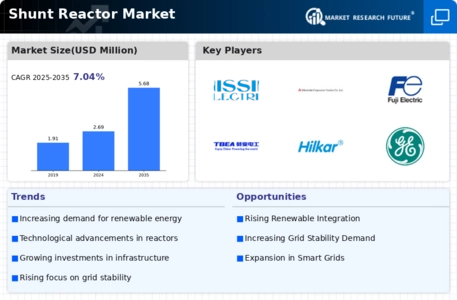Top Industry Leaders in the Shunt Reactor Market

*Disclaimer: List of key companies in no particular order
In the ever-evolving landscape of the shunt reactor market, growth is propelled by increased investments in renewable energy, expanding power grids, and a rising demand for voltage control solutions. The market dynamics are shaped by a select group of established players, resulting in fierce competition that underscores the importance of innovation and differentiation.
Key Players and Strategic Approaches:
Leading the shunt reactor market are key players such as Zaporozhtransformator (Ukraine), Siemens AG (Germany), ABB (Switzerland), Crompton Greaves (India), Hyundai Heavy Industries (Korea), Fuji Electric Co. Ltd (Japan), Mitsubishi Electric Corporation (Japan), TBEA (China), TRENCH Group (France), and Hilkar (Turkey). Other notable entities include ABB Ltd, Siemens AG, CG Power and Industrial Solutions Limited, Mitsubishi Electric Corporation, Hitachi ABB Power Grids Ltd., General Electric Company, Toshiba Corporation, Hyosung Heavy Industries Corp., and Fuji Electric Co., Ltd. These industry leaders employ diverse strategies to solidify their market positions:
-
Product Innovation: Substantial investments in research and development are directed toward introducing cutting-edge shunt reactor technologies. Variable shunt reactors (VSRs) are a focal point, with efforts aimed at enhancing efficiency, controllability, and designing units that are both compact and lightweight.
-
Geographical Expansion: Established players strategically expand into emerging markets, particularly in Asia-Pacific and Latin America, recognizing the substantial anticipated growth in demand for shunt reactors in these regions.
-
Strategic Partnerships and Acquisitions: Collaborations and acquisitions play a pivotal role in gaining access to new technologies, broadening geographical reach, and fortifying market positions.
-
Focus on Cost Reduction: Manufacturers optimize production processes and sourcing strategies to reduce costs, thereby enhancing price competitiveness.
-
Digitalization and Smart Technologies: The integration of digital technologies and smart grids into offerings aims to provide advanced solutions for voltage control and grid stability.
Market Share Determinants:
Several factors influence the market share of shunt reactor manufacturers:
-
Brand Reputation and Market Presence: Well-established players with strong brand reputations enjoy larger market shares.
-
Product Portfolio and Technological Expertise: Companies offering a diverse range of shunt reactors with advanced features and technologies gain a competitive advantage.
-
Manufacturing Capabilities and Cost Efficiency: Efficient production facilities and cost-effective sourcing strategies enable manufacturers to offer competitive pricing, attracting a broader customer base.
-
Customer Service and After-Sales Support: Companies prioritizing customer service and reliable after-sales support foster long-term relationships with customers and encourage repeat business.
-
Geographical Reach and Distribution Network: A global presence and well-established distribution networks enable manufacturers to cater to a wider customer base, contributing to increased market share.
Emerging Trends:
The competitive landscape is further influenced by emerging trends:
-
Growing Demand for VSRs: Variable shunt reactors gain popularity due to their superior voltage control capabilities, adapting to changing grid conditions and creating opportunities for both new entrants and established players.
-
Sustainability and Environmental Focus: Manufacturers increasingly develop eco-friendly shunt reactors with minimal environmental impact, utilizing biodegradable materials or renewable energy sources.
-
Digitalization and Smart Technologies: The integration of digital technologies and smart grids transforms the shunt reactor market, enabling real-time monitoring, data analytics, and predictive maintenance.
-
Rise of Regional Players: Regional players, particularly in Asia-Pacific, emerge as significant competitors, challenging established global players.
Market Outlook and Strategic Imperatives:
The global shunt reactor market is fiercely competitive, characterized by continuous technological advancements, an increasing demand for VSRs, and a growing emphasis on sustainability. To thrive in this dynamic environment, companies must prioritize innovation, geographical expansion, strategic partnerships, and customer-centric approaches. Furthermore, embracing digitalization and smart technologies is crucial for manufacturers to differentiate themselves and maintain a competitive edge.
Industry Developments and Latest Updates:
-
Nissin Electric (October 26, 2023): Secured a contract to supply 245kV shunt reactors for a new substation project in Japan.
-
ABB (September 20, 2023): Commissioned a 400kV shunt reactor for a grid expansion project in Germany.
-
Mitsubishi Electric (June 14, 2023): Launched a new series of high-efficiency and low-noise shunt reactors for industrial applications.
-
Crompton Greaves (July 28, 2023): Successfully completed the installation of a 400kV shunt reactor for a renewable energy project in India.
-
Fuji Electric (May 19, 2023): Unveiled a new generation of digitally controlled shunt reactors for enhanced grid stability.









